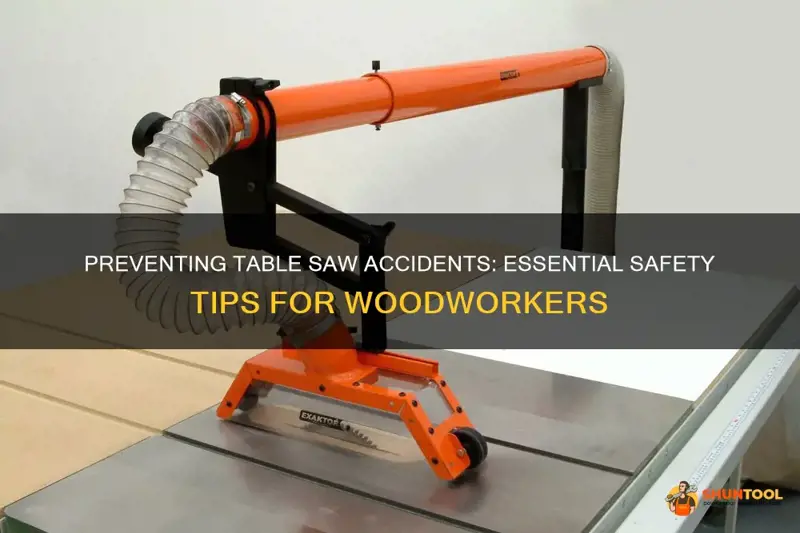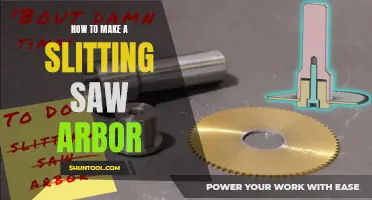
Table saw accidents can have devastating consequences, from severe injuries to even loss of limbs. However, with the right safety precautions and practices, these accidents can be prevented. By understanding the risks, wearing protective equipment, maintaining a clean workspace, and following proper cutting techniques, woodworkers can enjoy both the productivity and safety that a table saw offers.
| Characteristics | Values |
|---|---|
| Use appropriate protective equipment | Safety glasses, ear plugs |
| Ensure the table saw is in good working condition | Regular maintenance |
| Use a push stick or block to keep hands away from blade | Use push stick or block |
| Avoid distractions while using the table saw | Focus on the task at hand |
| Keep the work area clean and free of clutter | Remove debris and obstacles |
| Use a riving knife or splitter to prevent kickback | Install riving knife/splitter |
| Use proper cutting techniques | Follow cutting guidelines |
| Never remove safety features | Keep all safety guards in place |
| Always use the appropriate blade for the task | Use the correct blade |
| Receive proper training and instruction | Learn how to use the saw safely |
What You'll Learn

Proper training and education for table saw users
Table saws are incredibly useful tools in the workshop, but they can also be dangerous if not used properly. Accidents involving table saws can result in severe injuries or even death. However, the good news is that many table saw accidents can be prevented through proper training and education for users. In this blog post, we will discuss the importance of proper training and provide some tips on how to use a table saw safely.
The first step in preventing table saw accidents is to receive proper training. Whether you are a beginner or an experienced woodworker, it is crucial to understand the correct and safe way to operate a table saw. Attending a safety training course or workshop can provide you with the necessary knowledge and skills to use the tool safely.
During a safety training course, users will learn about the different components of a table saw, including the blade, guard, splitter, and fence. The course will teach users how to properly set up the saw, align the blade, and adjust the height and angle of the blade for different cuts. Additionally, users will be instructed on how to use push sticks and other safety accessories to keep their hands and fingers away from the blade.
In addition to receiving formal training, there are several safety practices that users should always follow when operating a table saw. First and foremost, it is essential to wear the appropriate safety gear, including safety glasses, hearing protection, and a dust mask. These items will help protect you from flying debris and reduce the risk of respiratory problems.
Before starting any cutting operation, it is crucial to inspect the saw and make sure that all the components are in good working condition. Check that the blade is sharp, the fence is aligned properly, and all safety features, such as the blade guard and the anti-kickback device, are in place. It is also important to verify that the power switch is off before plugging in the saw.
Whenever using a table saw, it is essential to maintain a clear and clean workspace. Remove any distractions, such as clutter or loose objects, from the area around the saw. Keep the tabletop clean and free of debris to ensure that the workpiece slides smoothly during the cut. Additionally, always use a push stick or a push block to guide the workpiece through the blade, keeping your hands at a safe distance.
When making a cut, it is crucial to use the appropriate cutting techniques. Do not rush or force the workpiece through the blade, as this can cause kickback or result in an uneven cut. Instead, use a steady and controlled motion, allowing the saw to do the cutting. When making repeated cuts, use a miter gauge or a sled for improved accuracy and safety.
Lastly, it is essential to be aware of your body position and stance when operating a table saw. Stand to the side of the blade, never directly behind it, to avoid injuries in case of kickback. Keep a firm grip on the workpiece and maintain a balanced and stable stance throughout the cutting operation.
In summary, proper training and education are crucial in preventing table saw accidents. By attending a safety training course and following the necessary safety practices, users can significantly reduce the risk of injury when using a table saw. Remember to always wear the appropriate safety gear, inspect the saw before use, maintain a clean and clear workspace, use the correct cutting techniques, and be mindful of your body position while operating the saw. With the right knowledge and precautions, using a table saw can be a safe and rewarding experience.
Cutting Polyurethane with a Chop Saw: Tips and Tricks
You may want to see also

Use of safety features and accessories
Table saws are incredibly useful tools, but they can also be extremely dangerous if not used correctly. In fact, table saw accidents are one of the most common causes of serious injuries in woodworking shops. That's why it's crucial to take steps to prevent accidents when using a table saw. One effective way to enhance safety is by using safety features and accessories that are specifically designed for table saws.
Here are some key safety features and accessories that can help prevent table saw accidents:
- Blade guards: A blade guard is a protective cover that encloses the blade, ensuring that it is not exposed during operation. It helps prevent accidental contact with the spinning blade and can significantly reduce the risk of serious injuries. Always use a blade guard when operating a table saw, unless the task requires its removal.
- Riving knife: A riving knife is a safety device that helps prevent kickback, which is one of the most common causes of table saw accidents. Kickback occurs when the workpiece gets caught or pinched between the blade and the fence, causing it to be forcefully thrown back towards the operator. A riving knife sits just behind the blade and helps keep the workpiece from twisting and binding, reducing the risk of kickback.
- Push sticks and push blocks: These accessories are essential for safely guiding and pushing the workpiece through the blade. They keep your hands at a safe distance from the blade, reducing the risk of accidental contact. Push sticks are primarily used for narrow workpieces, while push blocks are suitable for wider and larger pieces. Always use appropriate push sticks or push blocks to maintain safe hand positioning and control during cuts.
- Anti-kickback pawls: These small, toothed devices attach to the riving knife and help prevent kickback by gripping the workpiece during a cut. When the workpiece moves forward, the pawls allow smooth progress, but if it moves backward, they dig into the wood, preventing the kickback motion. Anti-kickback pawls provide an additional layer of protection against kickback, and their use is highly recommended.
- Featherboards: Featherboards are designed to apply pressure against the workpiece, keeping it firmly against the fence or table. By preventing the workpiece from shifting or moving during a cut, featherboards help reduce the likelihood of kickback and other accidents. They are especially useful when working with longer or wider boards.
- Splitter: Similar to a riving knife, a splitter is a vertical projection located just behind the blade. It helps prevent the workpiece from pinching against the back of the blade, reducing the risk of kickback. Splitters are particularly effective for making non-through cuts or when a dado blade is used.
- Outfeed support: Proper support for the workpiece throughout the cut is crucial for safe table saw operations. An outfeed support, such as a roller stand or a table extension, helps prevent workpieces from falling or shifting after they pass through the blade. This reduces the risk of injury and ensures accurate and controlled cuts.
It's important to note that safety features and accessories alone cannot guarantee complete protection. Always follow safe work practices, such as wearing appropriate personal protective equipment, maintaining a clean and clutter-free work area, and using proper cutting techniques.
By utilizing these safety features and accessories, you can greatly reduce the risk of table saw accidents and work with confidence. Remember, woodworking is a rewarding hobby or profession, but safety should always be the top priority.
A Step-by-Step Guide to Oil a Circular Saw for Optimal Performance
You may want to see also

Regular maintenance and inspections of table saws
Here are some important steps to take when it comes to maintaining and inspecting your table saw:
- Clean and lubricate moving parts: Dust, debris, and sawdust can accumulate on the table saw's moving parts, such as the blade, arbor, and fence. Regularly clean these components using a brush or compressed air to ensure they move freely and smoothly. Additionally, apply lubricant to the appropriate areas to reduce friction and prevent binding.
- Check the blade for damage: Inspect the table saw blade for any signs of wear or damage. Look for missing or chipped teeth, bent blades, or excessive vibration when the saw is running. These issues can lead to kickbacks, uneven cuts, and other dangerous situations. If any problems are detected, replace the blade immediately.
- Align the blade and fence: Proper alignment of the blade and fence is crucial for accurate and safe cutting. Use a square to check if the blade is parallel to the miter slots or the fence. Also, ensure that the fence is parallel to the blade. Any misalignment can cause the wood to bind or kickback during cutting, increasing the risk of injury. Adjust the blade and fence as necessary to achieve proper alignment.
- Inspect the blade guard and splitter: The blade guard and splitter are essential safety features designed to protect you from contact with the blade. Regularly check these components to ensure they are intact and functioning correctly. Make sure the guard moves freely and springs back into place after use. Replace any damaged or missing parts immediately.
- Verify the safety features: Table saws come equipped with various safety features, such as a riving knife, anti-kickback pawls, and a push stick. Regularly inspect these elements to ensure they are in working condition. The riving knife should be properly aligned with the blade to prevent kickback, while the anti-kickback pawls should engage and disengage smoothly. Replace any damaged or worn safety features promptly.
- Inspect the power cords and switches: Check the power cords for any signs of damage, such as fraying or exposed wires. Make sure the cords are not tangled or in the path of the saw blade. Additionally, test the power switch to ensure it turns the saw on and off smoothly. Faulty cords or switches can lead to electrical hazards. Replace damaged cords or switches immediately.
- Conduct regular electrical checks: Table saws rely on electricity to operate, so it is essential to check the electrical connections regularly. Inspect the plugs, outlets, and wiring for any signs of damage or loose connections. Faulty electrical connections can cause the saw to malfunction or pose a safety hazard. If you are not proficient in electrical work, consult a qualified electrician to perform these checks.
In conclusion, regular maintenance and inspections of table saws are vital for preventing accidents and maintaining a safe working environment. By cleaning and lubricating the moving parts, checking for blade damage, aligning the blade and fence, inspecting safety features, and conducting electrical checks, you can ensure that your table saw operates safely and efficiently. Remember to always follow the manufacturer's guidelines and recommendations for maintenance and safety procedures.
Why Circular Saws With Long Handles Are Essential for Precision and Safety
You may want to see also

Safe operating techniques and practices
As with any power tool, it is essential to prioritize safety when operating a table saw. Table saws can be incredibly dangerous if not used properly, often resulting in severe accidents and injuries. By following a few safe operating techniques and practices, you can greatly reduce the risk of accidents and create a safer working environment. Here are some important guidelines to consider:
- Read and Understand the Manual: Before using a table saw, thoroughly read and understand the manufacturer's manual. It provides essential information on safety guidelines, proper usage, and maintenance instructions. Familiarize yourself with the controls, functions, and features of the saw before you start operating it.
- Wear Appropriate Safety Gear: Always wear the appropriate safety gear when using a table saw. This should include safety glasses or goggles to protect your eyes from flying debris, ear protection to guard against the loud noise, and proper clothing to avoid loose-fitting items that could get caught in the saw blade.
- Maintain a Clean Work Area: Keep your workspace organized and free from clutter. Remove any scrap wood, tools, or other debris that may obstruct your movement or increase the risk of accidents. A clear work area allows for better focus and reduces the chances of accidental contact with the saw blade.
- Use a Riving Knife or Splitter: A riving knife or splitter is a crucial safety accessory that helps prevent kickback. It keeps the workpiece from binding against the back of the saw blade and reduces the risk of it being thrown back towards the operator. Make sure to use and adjust the riving knife or splitter according to the manufacturer's instructions.
- Ensure the Blade Guard is in Place: The blade guard serves as a protective barrier between your hands and the saw blade. Always ensure that the blade guard is properly installed before operating the table saw. It should move freely with the material being cut and not impede your line of sight.
- Use Push Sticks or Push Blocks: When making narrow or small cuts, use push sticks or blocks to keep your hands safely away from the blade. These tools allow you to apply even pressure and control the workpiece without risking your fingers.
- Never Perform Free-Hand Cuts: Trying to cut wood without using a fence or guide can be extremely dangerous. Always use a fence, miter gauge, or other appropriate guides to ensure accurate and safe cuts. Free-hand cuts are unpredictable and significantly increase the chances of accidents.
- Keep Hands Away from the Blade: As a general rule, you should always keep your hands at least 6 inches away from the saw blade. Avoid reaching over the blade or bringing your fingers too close to it while cutting. If necessary, use a push stick or block to move the material through the saw blade.
- Avoid Distractions: Keep your full concentration on the task at hand when operating a table saw. Distractions can lead to errors and accidents. Avoid using a table saw when tired, under the influence of drugs or alcohol, or in a rush. It's crucial to stay focused and alert to ensure safe operation.
- Practice Proper Blade Changing Procedures: When changing the saw blade, ensure that the table saw is unplugged and the blade has come to a complete stop. Follow the manufacturer's instructions for blade replacement, including the proper use of the blade wrench and ensuring the blade is securely attached before resuming operation.
By following these safe operating techniques and practices, you can greatly reduce the risk of table saw accidents. Remember, safety should always be your top priority when using any power tool. Invest the time to learn proper techniques, follow the guidelines, and never rush through a project. Safe operating practices will create a more secure and enjoyable woodworking experience for you and those around you.
Understanding the Uses of a Wet Saw for Concrete: A Comprehensive Guide
You may want to see also







